The Pain-Free Three workout was created years ago for NIFS Mini Marathon runners and walkers, the moves are effective for a quick and easy way to boost your leg and core strength. You will develop the supporting muscles to balance out the weakness you may have. Strengthen your glutes, and hamstrings with the Deadlift. The quads and core get work with Lunge variations and the upper body and core get work with the Inchworm. As with any program consistence is the key. There is a training plan below but a few reps of each of these before and after your running or walking will keep your body strong as you increase your mileage in the coming weeks. Running the Mini Marathon is a wonderful way to test your fitness, but the last thing you want is to be hurting at the starting line.
Three moves to assist you in being your best!
These exercises can serve as a warm-up and/or cool-down. While they initially may be difficult to perform, keep working at them and ultimately they will serve as a perfect complement to your running or walking routine.
Weeks 1 – 8: Perform exercises 3 times per week.
Weeks 9 – 14: Perform exercises 2 times per week.
Weeks 15 – 16: Perform exercises once per week.
1. One Leg Deadlift with Touch (Hamstring, Glute, Back, Core, Shoulder)
Stand tall on one leg (knee slightly bent); stay stiff from the top of your head to the opposite heel.
Place a target in front of you and one on each side. Hinge at your hips, and lean forward, until your body is in a T shape. Using the opposite hand of the leg you are standing on, reach in front of you as far as possible. Slowly return to the start position. Adjust targets if needed.
Next, hinge at the hips and reach out to the opposite side of the leg you are standing on. Slowly come back to start.
If you need help staying balanced, hold onto a chair, brace against a wall, etc. with a non-reaching hand. Each week you will notice your balance improving and your flexibility allowing you to reach further!

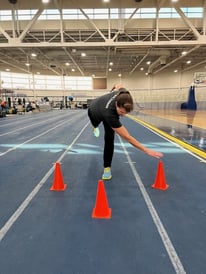
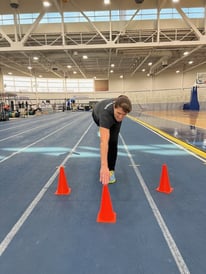
2. Lunge progression (Total Body)
Standing tall, bring your knee and toe up as high as possible without tilting back.
Stride out into a lunge with your front ankle directly under your knee, back knee flexed (knee may touch the floor to decrease difficulty), and shoulders over hips (not tilted forward).
Targeting the IT Band: At the bottom of the lunge, extend the arm opposite of the stride leg up and lean over to the opposite side. Feel the stretch along your side, down to the hip. Come back to the center and push off the back leg to start the next step. Proceed with high knee/ toes on that leg (squeezing the glute of the standing leg will help with stability). Perform 2 lunges and stretches per leg.
Targeting the Total Body: At the bottom of the lunge, bring your arms up and bend your elbows to 90 degrees. Turn your shoulders toward the side of the front leg, looking as far to that side as you can. Turn back and stride into the opposite side. Perform 2 lunges and stretches per leg.
3. Inchworm
Begin with your hands and feet touching the floor (bend knees, if necessary). Walk your hands out to the push-up position. Perform 2-5 pushups, keeping your body in a straight line. Drop to your knees if you cannot keep your hips from sagging (quality over quantity).
After the last push-up, keep your hands planted, and drive your hips up, then take small steps forward (driving your heels into the floor) until your knees are slightly bent. Walk out with your hands again and perform 2-5 push-ups.
After the second set of push-ups, bend your knees and walk your feet to your hands. Shift your weight to your feet and slowly rise. Perform 4-6 repetitions.
This blog was written by Kris Simpson, BS, ACSM-PT, HFS, personal trainer, and USTA at NIFS. To read more about the NIFS bloggers, click here.


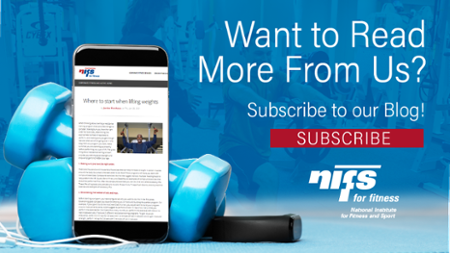
.jpg?width=480&height=309&name=GettyImages-1448979924(2).jpg) In today's fast-paced world, where new diet trends and health fads emerge almost daily, it can be challenging to discern what truly benefits our bodies. Amid this whirlwind of ever-changing advice, the key to a healthier life may not lie in exotic superfoods or rigorous diet regimens, but in the consistent practice of nutritional basics.
In today's fast-paced world, where new diet trends and health fads emerge almost daily, it can be challenging to discern what truly benefits our bodies. Amid this whirlwind of ever-changing advice, the key to a healthier life may not lie in exotic superfoods or rigorous diet regimens, but in the consistent practice of nutritional basics.


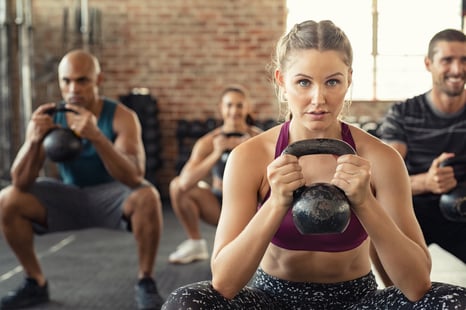 Functional training is an excellent approach for longevity and maintaining a healthy lifestyle and functioning body because it emphasizes movements that mimic activities of daily living, enhance flexibility, and improve overall mobility. In this blog, you will learn about the different functional exercises that can contribute to your longevity, along with their benefits and daily function.
Functional training is an excellent approach for longevity and maintaining a healthy lifestyle and functioning body because it emphasizes movements that mimic activities of daily living, enhance flexibility, and improve overall mobility. In this blog, you will learn about the different functional exercises that can contribute to your longevity, along with their benefits and daily function.  Happy New Year! As we embark on a journey to transform our lives through physical fitness, mental well-being, and a balanced lifestyle by exploring the components of a holistic approach to health that will help you achieve your fitness goals and lead a fulfilling life.
Happy New Year! As we embark on a journey to transform our lives through physical fitness, mental well-being, and a balanced lifestyle by exploring the components of a holistic approach to health that will help you achieve your fitness goals and lead a fulfilling life. Roughly how many hours of sleep would you say that you average per night? Six hours? Ten hours? Now think about your fitness goals and the results you want to see from exercising. Are you where you would like to be, or are you on pace to get to where you would like to be? You can be doing everything correctly from the exercises that you perform, nutrition and supplementation, stress reduction, whatever it may be, and you aren’t quite getting the results you’re looking for.
Roughly how many hours of sleep would you say that you average per night? Six hours? Ten hours? Now think about your fitness goals and the results you want to see from exercising. Are you where you would like to be, or are you on pace to get to where you would like to be? You can be doing everything correctly from the exercises that you perform, nutrition and supplementation, stress reduction, whatever it may be, and you aren’t quite getting the results you’re looking for. 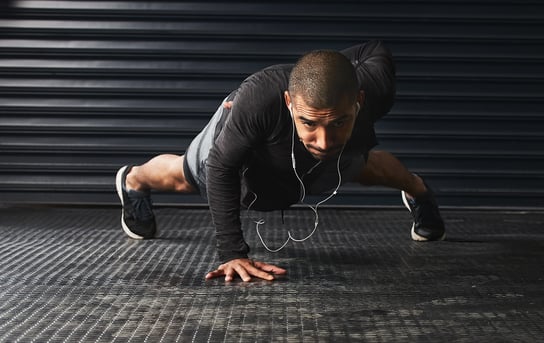 If you’re like me and absolutely love listening to music and discovering new artists, genres, etc., then I could bet that you most likely listen to music while you exercise. Combining music and workouts has become a common practice among fitness enthusiasts because it can provide a boost of motivation and energy for when you’re testing your one-rep max or just taking a brisk walk outdoors. However, in this blog I will discuss the potential drawbacks of listening to music during a workout/training session and, hopefully, it will make you think about how music (or no music) plays a role in your training.
If you’re like me and absolutely love listening to music and discovering new artists, genres, etc., then I could bet that you most likely listen to music while you exercise. Combining music and workouts has become a common practice among fitness enthusiasts because it can provide a boost of motivation and energy for when you’re testing your one-rep max or just taking a brisk walk outdoors. However, in this blog I will discuss the potential drawbacks of listening to music during a workout/training session and, hopefully, it will make you think about how music (or no music) plays a role in your training..jpg?width=537&height=358&name=GettyImages-1187356524(1).jpg) In an athlete’s world, every fraction of a second and inch of athletic performance are significant for them to play at their best on and off the field. However, being an athlete means consistently searching for innovative ways to elevate your game. This is where fascia training enters the conversation as one of the many ways of improving one’s athletic performance. Fascia training is an emerging topic that holds the promise of unlocking your untapped potential and improving your performance.
In an athlete’s world, every fraction of a second and inch of athletic performance are significant for them to play at their best on and off the field. However, being an athlete means consistently searching for innovative ways to elevate your game. This is where fascia training enters the conversation as one of the many ways of improving one’s athletic performance. Fascia training is an emerging topic that holds the promise of unlocking your untapped potential and improving your performance.  If you’ve been into fitness for a while, you likely know how important it is to fuel and replenish your body before and after exercise with the proper nutrition. However, you might be uncertain and confused about why, when, and what to eat and drink to optimize your workouts.
If you’ve been into fitness for a while, you likely know how important it is to fuel and replenish your body before and after exercise with the proper nutrition. However, you might be uncertain and confused about why, when, and what to eat and drink to optimize your workouts.